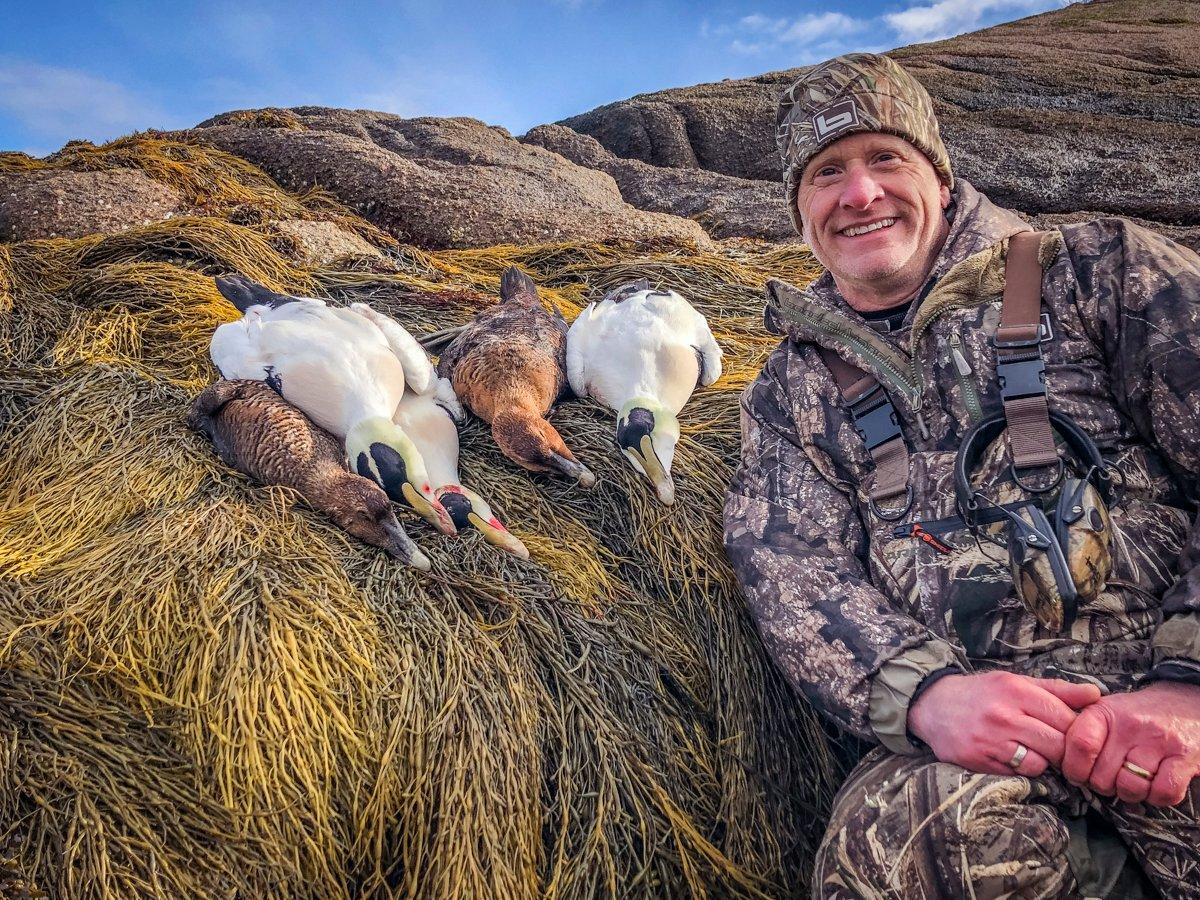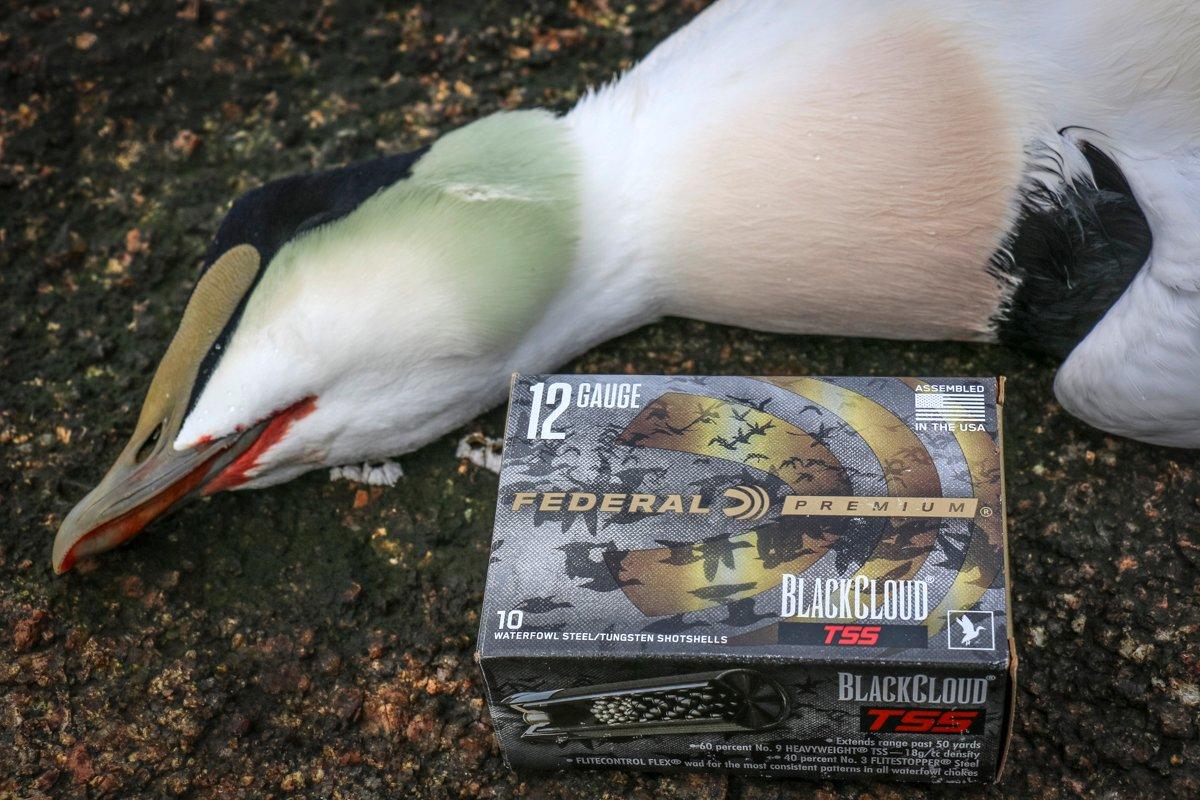Big Seas, Wild Surroundings and Fast Action Highlight Adventure
Hey, that's my boat.
Well, it wasn't really my boat. The big aluminum V-hull was the same make, model and color as my open-water duck craft. In fact, they even had similar 115-horsepower four-stroke motors and smaller kicker motors. But glancing at the gray surroundings in the still November dawn, I knew that's where the similarities ended.
Decoy bags with huge white blocks crowded the stern, and the unmistakable aroma of saltwater wafted across the breeze. No, this boat wasn't plying my familiar inland diver lakes. It was loaded for common eiders in Penobscot Bay in the Gulf of Maine — and it was taking me along for the ride.
As a lifelong diver hunter, I'd always dreamed of hunting sea ducks on the ocean. Thanks to friends at O.F. Mossberg and Sons and Federal Premium, I got my chance in late November 2018. Better, we'd be hunting common eiders, one of the world's largest and most colorful ducks. I'd shot a smattering of sea ducks at home — longtails, black scoters and white-winged scoters — but to a Midwestern hunter, the prospect of gunning eiders almost seemed like scaling Everest.
Fellow hunters and I piled into the boats and hunkered down as we sped away from the port. Our expert volunteer guides — Ron Spencer, Brad Allen, Wally Martin and Bill Brown — steered us through what seemed like an infinite maze of buoys, rock shoals and roiling water, finally stopping at a small rock island at the mouth of a long bay.
Careful on the rocks, Martin said in his Maine accent. Those weeds are slippery.
He wasn't kidding. We stumbled and slid across the barnacle-crusted boulders as the crew placed several long lines of eider blocks and a large eider-styled spinner. And even as the tender boats slipped away toward hidden shorelines, dark, unmistakable forms began piling past our setup.
Shoot! Brown said. But I wasn't loaded yet. He groaned as I watched what might have been my first eider zip past at 30 yards.
Finally ready, I soon spied more incomers. A flock of four hit the outside string and banked gracefully into the kill hole. And without thinking, I rose, fired and had my first drake eider. Fittingly, Brown's yellow Lab, Eider, made the retrieve.
Stumbling from my rocky perch, I hoisted the heavy drake by his bill, marveled at its stark-white plumage and studied the black, green and yellow on its marvelous head and bill. I probably would have remained in my daydream for much longer had another hunter not snapped me back to reality.
Out front, someone said.
Back to the rocks, as eiders were filing by. Several more fell, including two more stunning drakes — one of which fell dead as a hammer at 50 yards, courtesy of Federal's new loads of No. 3 steel and No. 9 TSS shot. Eider and the tender boats kept busy corralling dead or crippled birds, and we didn't lose a duck.
Finally, the sun peeked out and temperatures warmed, signaling the end of our morning. As we shared smiles, photos and memories — including a miss or two — our Mainer friends picked up decoys and signaled us to climb aboard. Lunch awaited.
The next day dawned dark and windy, and our guides debated whether we could safely hunt. However, thanks to their knowledge of the bay and its many lee shores, we made the run without getting wet and were set up by dawn. The stiff north breeze made shooting interesting, but we soon had a hefty pile of ducks to offset a few — OK, maybe more than a few — whiffs.
One duck stood out from the rest that morning. I noted its familiar silhouette and held fire as it sailed past, but a friend to my right probably wasn't accustomed to seeing that species and shot it. Martin's boat retrieved the bird, and he quickly got on the marine radio to needle us. Who shot the meh-ganzah? We chuckled more at the announcement than the fact we'd taken a sawbill.
Day 3 brought slow action at a scoter and longtail spot, but the highlights included some dandy merganser flights and a stunning black duck in the bag. No one minded the off day, as we shot photos, soaked up the ocean air and gazed across the bay as lobster boats and other crafts stirred up the water. We'd say farewell that afternoon, but I'm not sure anyone really wanted to depart.
After returning home, longing for my next dinner of fresh lobster and with two prime eiders shipped to the taxidermist, I often drifted back to the rock islands and evergreen-lined shorelines of Maine. I'll return someday, I hope, to again feel the sea spray and witness a New England sunrise. Moreover, I'll look forward to the next glimpse of cupped eider wings floating over white decoys — a sight I'll forever associate with wild waters of the Gulf of Maine.
Click here for more Realtree waterfowl hunting content. And check us out on Facebook.








